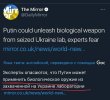I wonder if there is anything at all that would be impossible for the Ukrainian authorities to do for reasons of morality, decency, cleanliness, etc.? This is a rhetorical question
https://tass.ru/politika/14063863?utm_source=yxnews&utm_medium=desktop
https://tass.ru/mezhdunarodnaya-panorama/14064219
14 MAR, 16:17
Russian Foreign Ministry: employees of the SBU and embassies of Ukraine personally hire militants from the Middle East
According to the Deputy Minister of the department Oleg Syromolotov, the Ukrainian nationalists themselves, without hiding, tell about it in social networks
MOSCOW, March 14. /tass/. Employees of the Security Service of Ukraine (SBU) and Ukrainian diplomats are actually openly engaged in the selection and hiring of terrorists from the Middle East to participate in hostilities against the Russian Federation. This was stated in an interview with TASS by the Deputy Minister of Foreign Affairs of the Russian Federation Oleg Syromolotov.
Russian Foreign Ministry: Kiev is recruiting terrorists from Syria
"It is disgusting that all this abomination is not being done in secret, but actually in the open. The work is carried out not only by nationalist organizations, but also by the embassies of Ukraine in a number of Middle Eastern states. For personal acquaintance and selection of candidates, employees of the Security Service of Ukraine are sent to the place," he stressed.
According to the deputy minister, the Ukrainian nationalists themselves, without hiding, tell about it on social networks. "In their anti-Russian frenzy, Bandera activists boast on social networks that they, they say, managed to recruit a certain militant, who has "hundreds of Russian tanks destroyed in Syria." With such "helpers", they say, victory over the enemy is guaranteed," Syromolotov pointed out.
On February 24, Russian President Vladimir Putin announced a special military operation in Ukraine in response to the appeal of the leaders of the republics of Donbass for help. He stressed that Moscow's plans do not include the occupation of Ukrainian territories, the goal is the demilitarization and denazification of the country.
Ukraine used a "Dot-U" with a cluster warhead on Donetsk. Dozens of people were killed
The victims of the strike were 23 people, another 18 were injured
MOSCOW, March 14. /tass/. On Monday, the Ukrainian military fired a Tochka-U tactical missile equipped with a cluster warhead at the center of Donetsk. The rocket was shot down, but due to the fall of debris, according to the latest data, 23 people were killed, at least 18 were injured.
In Moscow and Donetsk, the use of "Dot-U" in residential areas has already been called a war crime. TASS has collected the main information about the missile strike.
The circumstances
of the Tochka-U strike, according to the Russian Defense Ministry, was launched around 11:30 Moscow time from the area of Krasnoarmeysk, which is controlled by Ukrainian nationalist formations. At about 12:00 Moscow time, there were reports of a rocket shot down over Donetsk, the wreckage of which, as a TASS correspondent reported, fell near the Government House and the Krupskaya Library, as well as on University Street.
According to the latest data of the Investigative Committee of the Russian Federation, 23 people were killed, including children, at least 18 were injured. The Defense Ministry reported 20 dead and 28 hospitalized.
On Monday, the deputy head of the People's Militia Department of the DPR, Eduard Basurin, said that the Ukrainian military is intensively shelling residential areas of Donetsk. Only over the past weekend, according to him, more than 50 objects of urban infrastructure were destroyed.
Cluster munition
The "Tochka-U" released in Donetsk, as stated by the head of the DPR Denis Pushilin, carried a cluster warhead. He stressed that to date, the Donetsk military has already shot down more than 15 missiles of this type, but so far they "have not been loaded with cluster-type ammunition."
As emphasized in the Ministry of Defense of the Russian Federation, the use of such ammunition proves that the purpose of the strike was to kill as many civilians as possible.
Cluster munitions are banned in almost all European countries, as well as in Australia, Canada, Japan and many other countries. Ukraine (as well as Russia and the United States) has not joined the relevant convention.
The reaction of the authorities
Pushilin called the use of the Tochka-U missile to bombard the center of Donetsk a war crime. "This is a monstrous crime of the Kiev regime. This certainly falls under a war crime. There is no opposition and no attempts to cause damage to the military infrastructure in this plan is not seen. This is a specific goal for the central part of the city. Where there are no military facilities and never have been," he said.
The head of the DPR assured that the object from where the missile was fired would be detected and destroyed. According to him, if the missile had not been shot down, there would have been disproportionately more victims, but even now "we can talk about the largest number of victims and wounded among the civilian population as a result of a one-time strike." Pushilin declared Tuesday, March 15, in the DPR a day of mourning for those who died as a result of a missile strike.
The Russian Defense Ministry also called the use of "Dot-U" a war crime and stressed that the decision on the use of such weapons should have been taken "at least by the command of the Ukrainian group of troops after approval by the leadership of the Armed Forces of Ukraine in Kiev."
The Investigative Committee opened a criminal case on the death of Donetsk residents under Part 1 of Article 356 of the Criminal Code of the Russian Federation ("The use of prohibited means and methods of warfare"), involving up to 20 years in prison.
Press Secretary of the President of the Russian Federation Dmitry Peskov, commenting on reports of a missile strike, replied that the Ukrainian military, "apparently, are acting on the hint and methodology of their overseas masters." "The Russian armed forces are working with modern high-precision weapons, hitting exclusively military and information infrastructure facilities," he recalled.
https://tass.ru/politika/14063863?utm_source=yxnews&utm_medium=desktop
https://tass.ru/mezhdunarodnaya-panorama/14064219
Интересно, существует ли вообще что то, что было бы невозможно сделать Украинской власти по соображениям морали, порядочности, чистоплотности и т.д.? Это вопрос риторический
Last edited:



